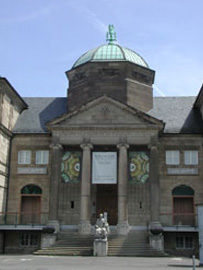Museum Wiesbaden
Friedrich-Ebert-Allee 2
In 1913, on the grounds of the former Hessian Ludwigsbahn in Friedrich-Ebert-Allee, construction was started on the three-wing museum designed by the museum's architect, Theodor Fischer. Previously, in 1821, the Palace of the Hereditary Prince had been expanded to house the collections of the Society of Antiquity in the Duchy of Nassau (Altertumsgesellschaft für das Herzogtum Nassau) and the Society of Antiquity Studies and Historical Research in Nassau (Verein für Nassauische Altertumskunde und Geschichtsforschung).
The two collections from these societies were the basis of today's collection at the Museum Wiesbaden which is operated by the Land of Hesse.
In the late 19th century, a shortage of space in the Palace of the Hereditary Prince led to the planning of a new building. The floor plan of the neo-Classicist structure is designed for a division into three collections: the Nassau antiquities, the natural sciences, and the painting gallery. Goethe urged that a museum be built when he stayed in Wiesbaden to use the spa facilities in 1814 and 1815, which is why the Goethe monument was placed at the museum's portico in 1919.



